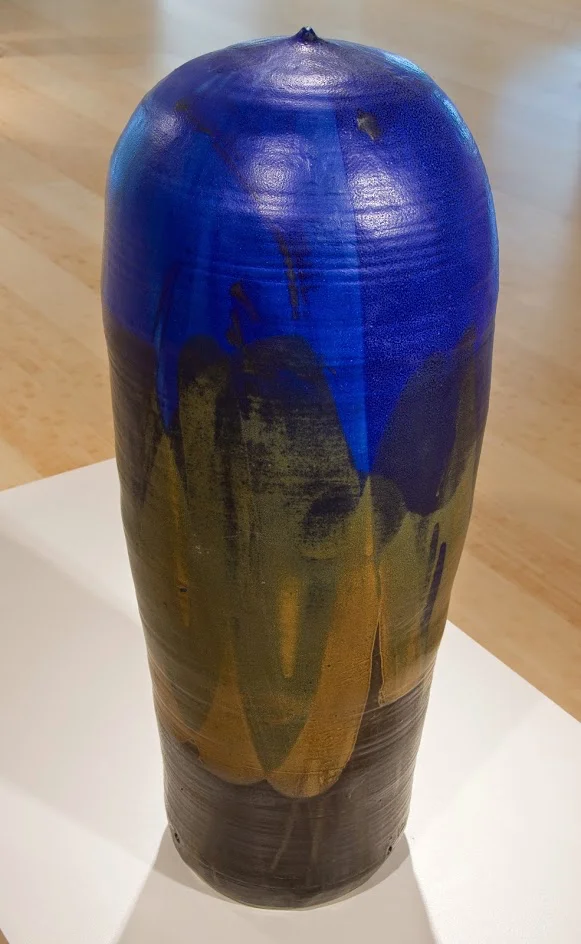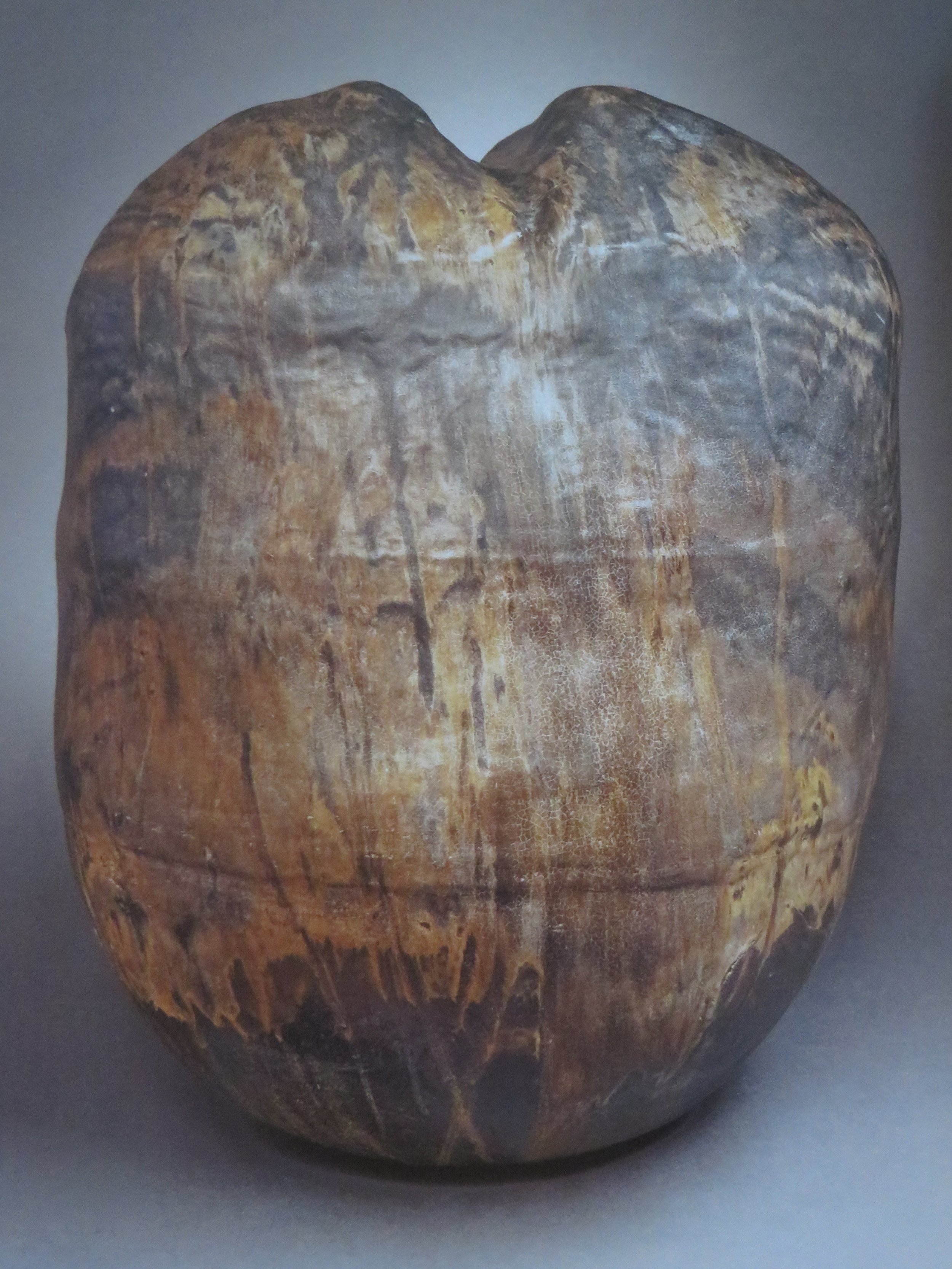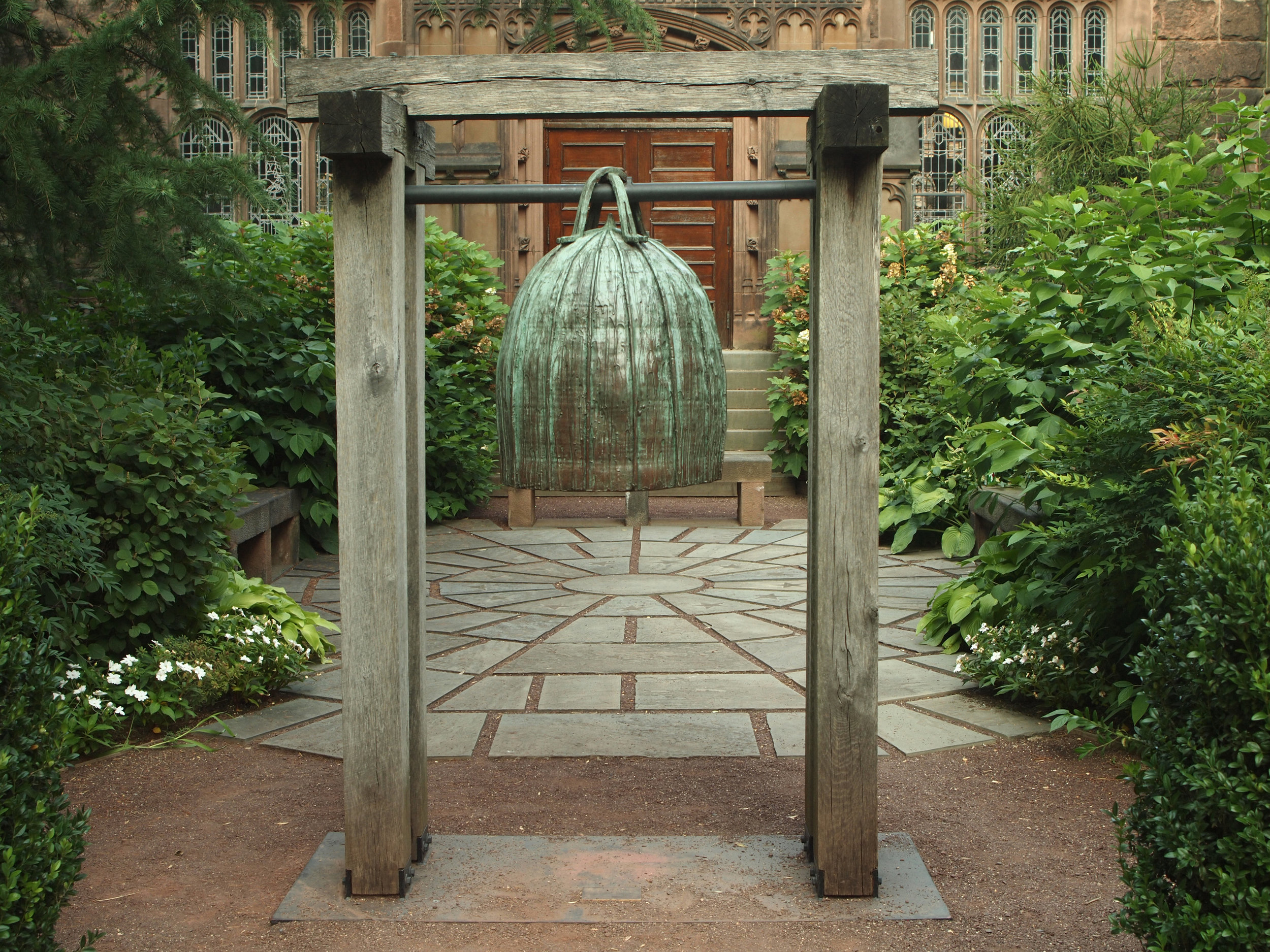ARTWORK
“You are not an artist simply because you paint or sculpt or make pots that cannot be used. An artist is a poet in his or her own medium. And when an artist produces a good piece, that work has mystery, an unsaid quality; it contains a spirit and is alive. There’s a nebulous feeling in the piece that cannot be pinpointed in words. That to me is good work!”
Toshiko Takaezu
Ceramic
Wheel-Thrown Closed Forms

Toshiko throwing a closed form at the Penland School of Crafts, North Carolina. Photo credit: Evon Streetman
“Toshiko Takaezu’s personal sculptural vision was shaped by the vessel tradition out of which it grew. Her earliest pieces are utilitarian ware – bulbous teapots and bottle vases – but these gradually metamorphosed into more eccentric shapes, multi-chambered and multi-spouted vessels in which expressive, sculptural qualities outweigh any potential for practical use. Through a continuous reductive process of experimentation involving refining and simplification of contours, surfaces and proportions, Takaezu arrived at the form which has become distinctly, unmistakable her own expression – a rounded, “closed form” with a vestigial neck and small ductlike opening in the top to allow interior gases to escape during firing.
In these works, the basic concept of the vessel is not violated, but the idea of implied/denied function is maximized, as the vessel has become simply a container of invisible space, with the eye forbidden access to the form’s interior. The duality of convex and concave spatial relationships offered in most utilitarian vessels is withheld and a unity is offered in its stead. The eye is confined to the surface of the form, to seeing and tracing its contour, compelled to move up and through the form until its compressed energy is released into space at the point where the tip of the nipplelike mouth touches the air. In this sturdy, simple design all the formal elements – line, volume, mass, implied space – come together in a rigorous unifying structure that contains subtlety, elegance, and sophistication.”
JAMES JENSEN
Curator of Contemporary Art, Honolulu Museum of Art
Toshiko Takaezu Retrospective, The National Museum of Modern Art, Kyoto, Japan, 1995.
Moons

Takaezu with her Moons : Photo Credit by Hiro
“While Takaezu continued to explore the rounded closed form throughout her career, she gradually introduced several new sculptural forms, each of which can be seen as an outgrowth of her sculptural image. Among the earliest of these are the “Moons”, stoneware spheres up to two feet in diameter which she sometimes also titles or refers to using the Hawaiian word for moon, “mahina”. In these works the rounded, closed form has metamorphosed, the tiny nipplelike spout disappearing so that the clay becomes one smooth, continuous membrane (although an unobtrusive flat hole is created on the underside of each piece, again permit expanding gases to escape in firing). On the moon’s uninterrupted surfaces, Takaezu gives free rein to her expressionistic glazing. Employing a range of gestures of varying length, direction and intensity, the artist creates calligraphic marking that drift delicately across the curves of the form in one section and becomes denser and more agitated in another. By quickly changing the position of the sphere as she applies glazes, Takaezu can make her strokes shift so that after firing they seem to defy gravity and struggle against the viscosity of their layering. Self-contained, these orbs are like miniature universes, with their storms of color encapsulating the emotional climate of the artist’s vision at any one moment in time”.
JAMES JENSEN
Curator of Contemporary Art, Honolulu Museum of Art
Toshiko Takaezu Retrospective, The National Museum of Modern Art, Kyoto, Japan, 1995.
Star Series

Takaezu walking amongst the Star Series. Photo credit : Tom Grotta, 1998
“Toshiko Takaezu viewed the Star Series as the magnum opus of her career. This 14-piece installation, created in 1999 and 2000 when the artist was in her late 70s, incorporates human-scale pieces that range from 46 inches to 68 inches in height. Takaezu sought to create a work the viewer could walk around and within, providing an immersive experience while also enabling one to fully contemplate each of the component pieces in the round.
Ultimately a synthesis of painting and sculpture, this is the largest work the artist produced. The scale of the closed forms gave her the opportunity to create substantial glaze paintings on surfaces that come energetically alive with poured and brushed color, recalling both Asian calligraphy and Abstract Expressionism. The Star Series also demonstrates Takaezu’s personal interest in nature and the forces it exerts on this planet as her imagery suggests the effects of a wide range of natural sources such as volcanic activity, waves on the shore, and the night sky.
Each sculpture that makes up the larger ensemble is named after a particular star or star-like object that comes from Egyptian mythology or the Dogon People of Mali in West Africa. […]
While designed to be installed as a group, Takaezu also planned for the individual sculptures that make up the installation to be exhibited in smaller, odd-numbered groupings that emphasize the importance of each individual work. This is similar to how we see the heavens as a single entity, while also focusing on individual stars when we look above.”
BRUCE W. PEPICH
Executive Director and Curator of Collections, Racine Art Museum, Racine, Wisconsin
To see a video of the first opening of the full Star Series (2006) at the Racine Art Musuem CLICK HERE
Hand-Built Closed Forms
Takaezu‘s hand-built closed sculptural forms were made using a variety of techniques including coil and slab construction and utilizing molds. She would often paddle the form to shape it and to ensure its structural integrity. Hand building freed Takaezu from the constraints of the wheel allowing her to investigate varied sculptural forms. The large organic works were another way for her to experiment with glaze, color, texture, and gestural mark making over many years of her practice.
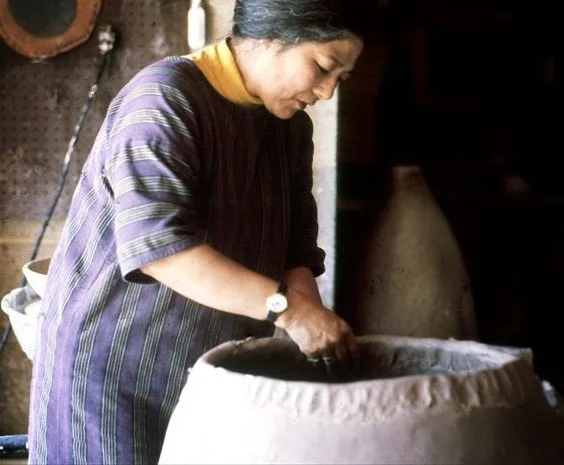
Takaezu working in her studio on a hand-built piece
Photo credit: Ceramics Monthly
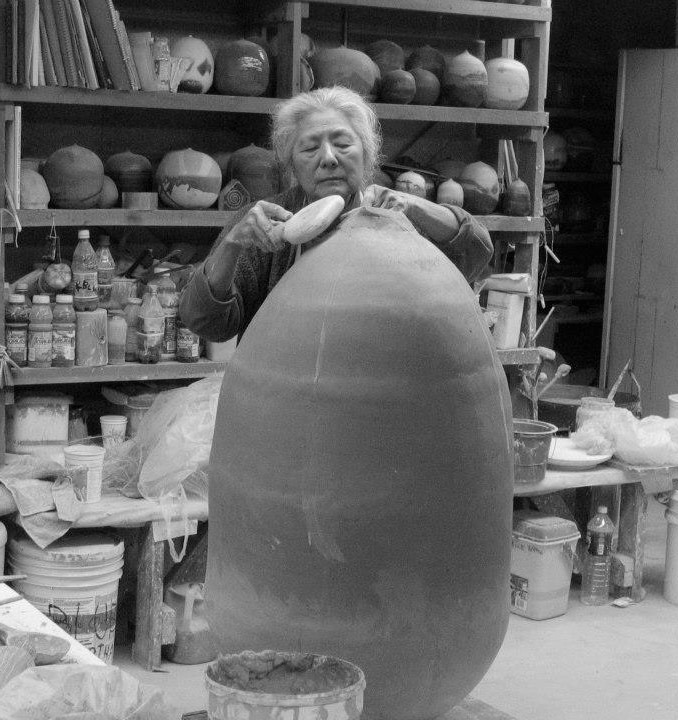
Takaezu paddling the top of a hand-built form. Photo Credit : Ben Eberle, 2003
Early Work

Three early works on display at the Takaezu Studio Gallery
Like most ceramic artists in the early 1950’s, Takaezu made a variety of utilitarian work including plates, bowls, bottle vases, tea pots. During her time at Cranbrook Academy and in Cleveland, she not only perfected her technique, but discovered "who she was", establishing her own unique artistic identity. She began transforming her functional ware into experimental shapes, multi-lobed, multi-spouted vessels. These vessels eventually were reduced to their essence, becoming increasingly expressive and more sculptural. This period of exploration ultimately lead to her signature “closed form.”
Takaezu said:
"I have disciplined myself in many ways in order to achieve my ideas. What is most important is to keep on working - you can't wait for inspiration because it may never come. Inspiration most often comes when I begin to work."
"After many years, a natural form arrived, one in which I enjoy and also one on which I could paint. I didn't want a flat surface to work on, but a three-dimensional one. "
"I was able successfully to merge the glaze as painting to the form, so that the two - painting and form - became one total and complete piece. In some ways this form and the painting on it have returned me to sculpture and painting on canvas. "
painting
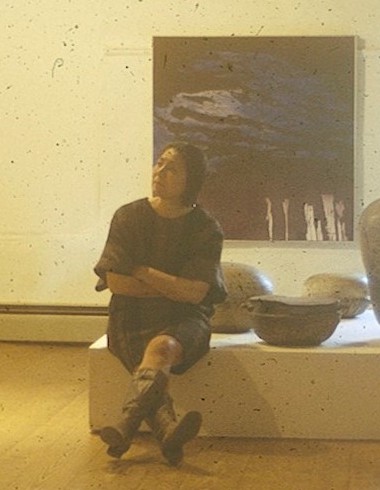
Takaezu at her exhibition “Toshiko Takaezu : Ceramics, Weaving, Painting” Hunterdon Art Center (now Hunterdon Art Museum) 1973, Cinton NJ. Photographer unknown. Toshiko Takaezu Archives
While Hawaii-born artist Toshiko Takaezu is internationally known for her ceramic works, for a brief period of time in the early 1970’s, when she didn’t have regular access to a kiln for firing clay, she occupied herself making paintings on canvas. This aspect of her work is little known among collectors and scholars.
Takaezu developed a highly personal and expressive approach to glazing her ceramic works. Generally this was a private and solitary process, intuitive, with quick bold gestures of glaze painted on the forms. Takaezu’s works have been likened to abstract expressionist paintings on clay. Not surprisingly, her interests in painting on canvas were similar, although it allowed her to paint on large, flat, rectangular or square surfaces rather than the curved contours of clay forms. The larger area for painting also allowed her to experiment with broad swathes of colors to a greater extent than in her ceramics. Painting with mixed acrylic pigments also allowed her to see immediately what was happening and react, change, add accordingly, whereas in glazing ceramics, the true colors only appear after firing.
Takaezu often liked the “surprise” of opening a kiln and seeing what her efforts yielded and the “gifts” of the firing process – unexpected colors or textures. With painting on canvas, Takaezu could experience greater control of the expressive, creative process. Nevertheless, in 1974, when Takaezu once again had a kiln, she stopped painting on canvas and returned to making only ceramics.”
JAMES JENSEN
Curator of Contemporary Art, Honolulu Museum of Art
Excerpt from: “Toshiko Takaezu: The Paintings”, Nov.3, 2011 - April1,2012, Honolulu Museum of Art at Chanel Waikiki
Weaving

Takaezu and Edie Carpenter examining Haleakala at “Toshiko Takaezu : The Art of Clay” at the GreenHill Center for North Carolina Art, Greensboro, NC, 2005. Photo credit : Mario Gallucci
Takaezu’s interest in the creative potential of fiber started at Cranbrook Academy where she studied weaving with Marianne Strengell. She was drawn to the texture of fiber and richness of color -deep blues, purples, browns, blacks, yellows, to create large fiber weavings. The color palette that she developed in these weavings would later inform her striking abstract expressionist and color field glazing of her clay works.
TreeS

Takaezu amongst the “Tree-Man Forest” in 1989. Contemporary Museum, Honolulu HI.
“Another sculptural form which emerged in the 1970’s and which reflects Takaezu’s strong relationship with nature and the landscape is a tall hollow cylindrical structure the artist refers to as a “Tree Form”. With truncated, flat tops or rounded ones that recall the silhouette of the artist’s classic rounded closed form, the tree forms draw their inspiration from the island of Hawaii’s Devastation Forest, the stark volcanic landscape with burned trees that stand amid the fields of broken lava which consumed them. Installed singly or, more often in groups such as “Lava Forest” and “Tree-Man Forest”, these forms create a powerful anthropomorphic presence, like sentinels standing in mute attention and guarding the land.”
JAMES JENSEN
Curator of Contemporary Art, Honolulu Museum of Art
Toshiko Takaezu Retrospective, The National Museum of Modern Art, Kyoto, Japan, 1995.
Utilitarian Works

Takaezu holding one of her tea bowls. Photographer unknown. Toshiko Takaezu Archives
As a ceramic artist who emerged in the postwar years of the 1950’s and 1960’s, Takaezu was instrumental in moving ceramics beyond its historical ties to the concept of function and into the realm of sculpture, transforming clay from something associated only with utilitarian objects to something that could be meaningful, capable of embodying abstract ideas.*
Her early utilitarian work included tea pots, tea bowls, plates, bowls, bottle vases, and square plates. While Takaezu’s early reductionist experimentation of these functional wares eventually lead to her signature “closed form”, she continued to make plates and bowls during her long career which embodied her striking abstract expressionist glazing.
*JAMES JENSEN
Curator of Contemporary Art, Honolulu Museum of Art
Toshiko Takaezu Retrospective, The National Museum of Modern Art, Kyoto, Japan, 1995.
Bronze

Takaezu with one of her bronze bells, 1991 Photo credit: Thomas Brummett
In the last decades of her career, Takaezu created a series of sculptural works in bronze at the Seward Johnson Atelier in Trenton, NJ. Using the lost-wax process, many of her bronze forms were extensions of her work in clay - trees, moons, and sculptural forms. Working in bronze enabled her to create forms that went beyond the structural properties of clay.
During this period, Takaezu created a series of bronze bells inspired by Japanese temple bells. Like those ancient precedents, Takaezu’s bells have no clappers. Instead, the bells are struck with a wooden mallet to produce rich, sonorous tones furthering her intent of integrating sound into her work. The surface treatments of these bells reflect a wide range of patinas, colors, and textures.
